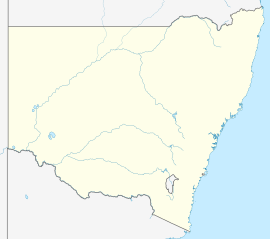Ballimore facts for kids
Quick facts for kids BallimoreNew South Wales |
|
|---|---|
| Population | 240 (2021 census) |
| Postcode(s) | 2830 |
| Location | |
| LGA(s) | Dubbo Regional Council |
| State electorate(s) | Dubbo |
| Federal Division(s) | Parkes |
Ballimore is a small village located in the Orana region of New South Wales, Australia. The name also refers to the countryside around the village. In 2021, about 240 people lived there.
The land where Ballimore is located today traditionally belongs to the Wiradjuri people.
Contents
Discovering Ballimore
Ballimore is about 31 kilometers (19 miles) east of Dubbo. You can find it along the Golden Highway. The village sits near where the Talbragar River and its smaller stream, Ballimore Creek, meet. The river borders one side of the village, and the Troy Junction–Merrygoen railway line borders another.
How Ballimore Started
The building of the railway line was very important for Ballimore. It led to the village being formed. Ballimore was officially declared a village on May 12, 1916. It's thought that the village was named after a place with the same name in Scotland.
Village Life and History
From 1918 to 1975, Ballimore had its own railway station. Even today, you can still see a railway siding, a silo (for storing grain), and a grain loader there. The village also has a public school and a hotel, which are important parts of the community.
Ballimore's Natural Resources
Ballimore is known for two main natural resources: coal and special mineral water.
Coal Mining in the Past
There is a lot of coal in the Ballimore area. People started mining this coal in the 1880s. The coal was good for creating steam, which was used to power machines and trains. However, it wasn't suitable for making certain types of gas or a fuel called coke.
The Famous Mineral Water
In 1887, while people were drilling to find more coal, they found something unexpected. At a depth of 550 feet (about 168 meters), they hit a source of artesian water. This means the water was under so much natural pressure that it could flow up pipes to about 30 feet (9 meters) above the ground! It flowed at a rate of 1,000 gallons (about 3,785 liters) per hour.
When this water was tested, it turned out to be high-quality mineral water. It had a lot of sodium bicarbonate, which is like baking soda.
Zetz-Spa Mineral Water
Starting in 1897, this special mineral water was collected using deep wells. It was sold under the brand name 'Zetz-Spa'. First, a company called Zetz-Spa Proprietary Company sold it. Then, from 1902, a well-known company called Tooths took over.
By 1951, there were three mineral water wells in the area. One was used by Tooths, another supplied Schweppes, and a third was used to water farm animals. Tooths continued to sell 'Zetz-Spa' mineral water until 1977.


